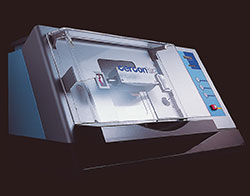High-end technology
The combination of our exceptional degree of expertise and extensive range of high-end production equipment is the basis for the highest possible quality in dental technology.
Our equipment includes:
etkon-es1 scanning technology

First we construct a model of the restoration on the basis of the dental imprints provided. Then we use our etkon es1 advanced laser scanner to make a three dimensional scan of the model. Special software can be used to electronically sculpt and perfect the scanning data – more accurately than could ever be done by hand.
The data is then transferred (via the internet) to the milling machine. The prosthesis is then milled from the selected high-performance materials, for example extremely high strength zirconia (Xawex G100 zirconium oxide, HIP zirconium oxide), aluminium oxide ceramic (Procera AllCeram, InCeram), metal (titanium and titanium alloy, CrCo Stella CAM) or plastic for temporary prostheses (glass fibre reinforced polyamide). The etkon technology is exceedingly well suited to meeting the demands of creating custom implant-based prostheses.
Cercon-CAD/CAM system

High quality white restorations can be manufactured using strong, fully biocompatible Cercon Smart Ceramics (zirconium oxide). This advanced structured ceramic material has exceptionally high flexural strength and fracture-resistance. We use it together with the Cercon CAD/CAM system specially designed for the material. Zirconium oxide, a natural material, is harder and stronger than other all-ceramic materials used for dental prostheses, making it the ideal solution for metal free bridges. It weighs less than gold and has very similar thermal conductivity to natural teeth. We give up to six years guarantee (material, laboratory costs and dentist’s fees) on all restorations manufactured using our Cercon system.
Procera-CAD/CAM system

The Procera CAD/CAM system was developed by the Swedish dentist Matts Andersson and the company Nobelpharma (today Nobel Biocare). We use it in the manufacture of ceramic crown frameworks from the densely sintered aluminium oxide Procera AllCeram.
A three dimensional scan is made of the plaster model of a prepared tooth stump using a high-resolution scanner. Fine adjustments can then be made on the computer. The data is then transferred via the internet to Sweden where the crown framework is milled from the ceramic material. It is then sent back to our laboratory where our dental technicians coat the framework with tooth-coloured material. In this way we can imitate nature, and even optimise it if necessary. The Procera technology provides the patient with an aesthetically outstanding result. Metal is not used, which means the crown has no dark edges. The Procera system, too, is used in the creation of custom implant-based prostheses.
...and, naturally, all the other technologies that belong to modern and aesthetic dental technology.
